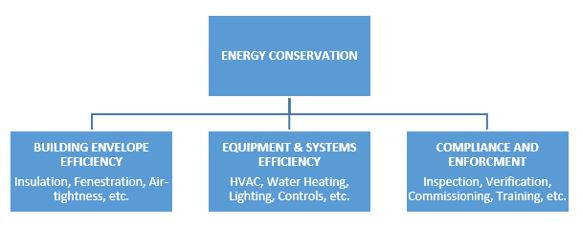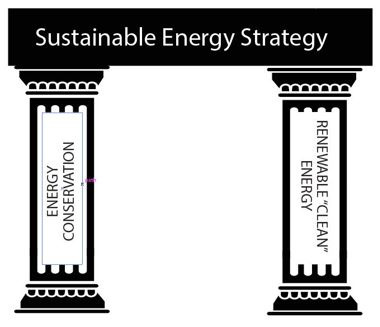It is well known that buildings consume more energy than the transportation or industry sectors, accounting for nearly 40 percent of total U.S. energy use. Therefore, energy efficiency in the building sector, representing about 120 million households and 5 million commercial buildings in the U.S., is the key to energy conservation. Energy conservation codes, such as the International Energy Conservation Code (IECC) and ASHRAE 90.1, set minimum requirements for energy efficiency measures used to conserve energy in new buildings (see Figure 1).
Figure 1. Building Energy Efficiency measures that contribute to energy conservation.

In addition, various public- and private-sector activities seek to encourage greater energy efficiency through innovation and best practices. We are on the right track and need to continue down the path of energy conservation to provide economic pay-backs as well as environmental benefits to sustain us well into the future.
Of equal importance is the source of the energy produced that is then conservatively consumed in buildings having robust energy efficiency measures (Figure 1). Sources of energy for buildings can be divided into two categories:
- non-renewable energy (e.g., natural gas, coal, fuel oil, nuclear, etc.) and
- renewable energy (solar, wind, hydro-electric, etc.)
Use of non-renewable energy sources tend to generate pollutants to varying degrees whereas renewable sources are “cleaner” and better for the environment to varying degrees. Clearly, the nuances and implications of the energy source(s) used is as important as the conservation of energy.
Whether you are concerned about the cost of heating and cooling your home, about the environmental impacts of your energy use, or about the national security implications of fossil fuels and nuclear power, energy conservation and increased use of renewable “clean” energy sources are the two pillars of any affordable, reasonable, and sustainable energy and environmental strategy (Figure 2).
But:
- How should these “pillars” work together for this common goal?
- What are the considerations for achieving a greater energy efficiency goal?
- What are the challenges to achieving a sustainable energy strategy with energy conservation and renewable energy production? For example, is it acceptable to permit energy efficiency to be traded-off for renewable energy production?
These important questions are addressed here.
Figure 2. Two Pillars of a Sustainable Energy Strategy

LEARN MORE:
- Thermal Insulation Resources
- Sustainability Resources
- Energy Code Math Lesson: Why an R-25 Wall is Not Equal to a R-20+5ci
- Wood Framed Wall Insulation Calculator Explained
- Perfect Walls Are Perfect, and Hybrid Walls Perfectly Good
- Fear Building Envelopes No More with This Website & Videos
- Polyiso CI Helps Designers Achieve a 'Perfect Wall'
- An R29 Wall Is More Energy Efficient When Built As R20+5ci Why?